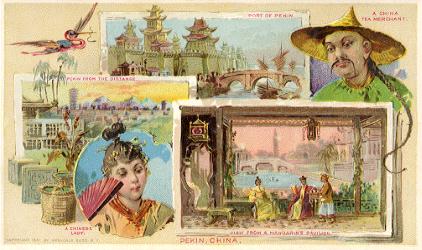|
|
VIEWS FROM A TRIP AROUND THE WORLD
#13 - PEKIN, CHINA
Size: 3" x 5"
Copyrighted: 1891
Lithographer: Joseph P. Knapp
  
Illustrations: Port of Pekin; A China Tea Merchant; Pekin from the Distance; A
Chinese Lady; View from a Mandarin's Pavilion
| Reverse - Text |
Left section:
GRIND
YOUR COFFEE AT HOME
Right section: |
| PEKIN, CHINA. |
| The Capital of the
Chinese Empire stands on the
northern extremity of the great
alluvial delta which extends from
its walls southward 700 miles.
Over the greater part of nine
centuries, under various names
and dynasties, Pekin has remained
an imperial city. During the
periods of those early
vicissitudes, the extent and
boundaries of the city materially
varied. |
| The
modern city consists of two
parts, the inner city know to
foreigners as the "Tatar
City," and the outer city
known thus as the "Chinese
City;" but these terms are
misleading, as what is called the
inner city is not enclosed within
the outer city, the southern wall
of the former resting squarely
against the northern wall of the
latter--the one outflanking the
other on either side. The outer
walls of the double city enclose
an area of about 25 square miles,
and measure 30 miles in
circumference. Unlike other
Chinese walls, these are kept in
perfect order. Those of the Tatar
portion are 50 feet high, with a
width of 60 feet at base and 40
feet at top, while those of the
Chinese City, built in 1543,
measure 30 feet in height; width
at base, 25 feet, and 15 feet at top. |
| Viewed
from the walls, Pekin has the
aspect of a city of gardens, with
a mass of gay temples, palaces
and mansions, their blue, green
and yellow glazed tiles shining
among the groves. |
| In
the "Imperial City" is
the "Purple Forbidden
City," which holds the
Emperor's Palace of unsurpassed
splendor, in which the Son of
Heaven holds his Court. The
Temple of Heaven is a noteworthy
building, where the Emperor
offers sacrifice and presents
prayers for various objects.
There are also altars to the
Earth, Sun, Moon and Agriculture. |
| There
is very little manufacturing done
in the city, the inhabitants
being consumers and not
producers. |
| Population , 1,648,000 |
|
|

![]()

![]()
